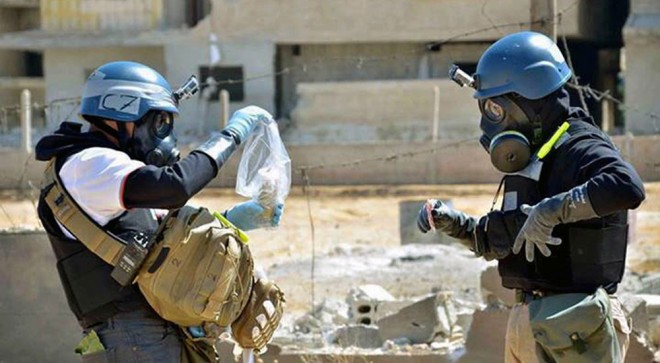
In this Wednesday, Aug. 28, 2013, file photo, a citizen journalism image provided by the United Media Office of Arbeen which has been authenticated based on its contents and other AP reporting, shows members of the United Nations investigation team take samples from sand near a part of a missile that is likely to be a chemical rocket, according to activists, in the Damascus countryside of Ain Terma, Syria. The Obama administration is offering to destroy some of Syria’s deadliest chemical weapons in international waters aboard a nearly 700-foot (213-meter), U.S. government-owned ship, U.S. officials told The Associated Press on Wednesday, Nov. 27, 2013. AP
WASHINGTON, US — The Obama administration is offering to destroy some of Syria’s deadliest chemical weapons in international waters aboard a nearly 700-foot (213-meter), US government-owned ship, US officials told The Associated Press on Wednesday.
The plan, still subject to final approval, would involve destroying the weapons, likely aboard the MV Cape Ray in the Mediterranean Sea, with U.S. Navy warships patrolling nearby.
This approach would avoid the vexing diplomatic, environmental and security problems posed by disposing of the materials on any nation’s soil.
The Obama administration has used international oceans in other sensitive cases where land-based options were precluded. The U.S. Navy buried al-Qaida leader Osama bin Laden at sea to avoid his tomb becoming an attraction for extremists. The government has been questioning terror suspects for as long as it takes aboard Navy ships since the CIA closed its secret prisons overseas and President Barack Obama has refused to send more prisoners to the detention center at the US base at Guantanamo Bay, Cuba.
The decision to proceed with the chemical disposal plan would be made by the Organization for the Prohibition of Chemical Weapons, a global chemical weapons watchdog agency with 190 member states.
In a statement Wednesday in the Netherlands, the watchdog agency said the effort to ship Syria’s chemical arsenal out of the country “continues to pose challenges due to the security situation on the ground.”
No country has committed to disposing of the chemical weapons on its own soil, which is why the U.S. offer to destroy the deadliest of the chemical components at sea is seen as a likely option.
The US officials who disclosed aspects of the US portion of the plan spoke on condition of anonymity because they were not authorized to talk about it by name.
Jonathan Lalley, a spokesman for the president’s National Security Council, stressed that no decisions had been made regarding destroying chemicals outside of Syria.
“We and our international partners are pursuing alternative means of destruction, and we will continue discussing with other countries how they might best contribute to that effort,” Lalley said in a statement. “We remain confident that we will complete elimination of the program within the milestones agreed upon.”
The MV Cape Ray would host the destruction of some of the deadliest of Syria’s chemical materials using a process developed by the Pentagon but never employed in an actual operation.
The US would use what it calls a mobile Field Deployable Hydrolysis System to neutralize the chemical material, making it unusable as weapons. The system was developed by the Defense Threat Reduction Agency, which is an arm of the Pentagon. The titanium reactor uses heated water and other chemicals to make the chemical warfare material inert.
According to several US officials, two of the hydrolysis units would be mounted on the Cape Ray. It will take some time to retrofit the ship and conduct training to insure that the process can be done successfully at sea.
Once the mission is finalized and the Cape Ray is ready, it would be transferred to control of the Defense Department’s Military Sealift Command. The ship is owned by the Transportation Department’s Maritime Administration and it would have a civilian crew.
US officials said they expect to use U.S. Navy ships to provide an escort and security for the operation. There are already a number of Navy warships in the Mediterranean.
As of Wednesday, U.S. officials said they are still trying to determine how the chemical warfare materials would be moved from Syria to the U.S. ship. They said they expect that another country will provide a ship for that part of the task.
Officials said they expect a final decision soon and the operation would begin by the end of the year.